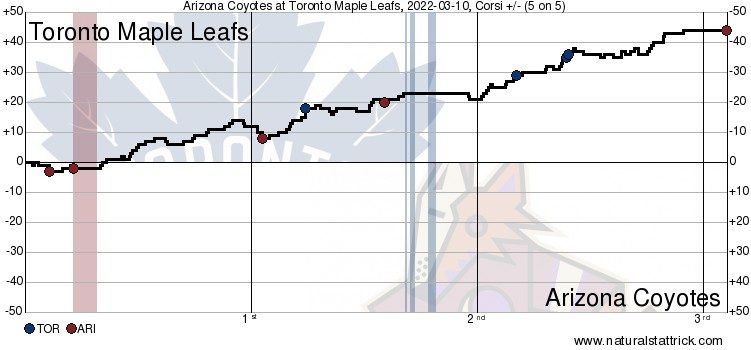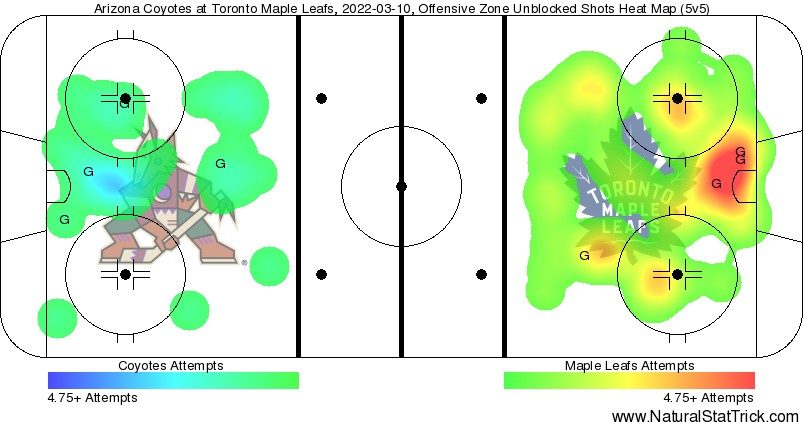
Never a dull moment for the Toronto Maple Leafs, even on a Thursday night against the Arizona Coyotes.
Where do you even start with this one?
Your game in 10:
1. Before we get to the main talking points about the Leafs‘ goaltending and the officiating, I don’t want to lose this post-game quote from Auston Matthews in the shuffle:
“We need to know — and we feel it every game, especially coming in here — that teams are going to be ready to play. They are going to be ready for us. It is Toronto. They are going to come in and give us their best game.
I think sometimes maybe we don’t show enough respect or just aren’t ready to play from the get-go. Teams come out hard, and we are flat-footed. Nights like tonight’s and in previous games, we dig ourselves a hole. Sometimes you can climb out of it, and sometimes we can’t. You rather just not play that game.”
To be clear, I didn’t think this was their worst start to a game in this recent stretch where they’ve given up a ton of goals (50 in their last 11 games). The top line generated some offensive-zone time on their first few shifts (including a few half-chances), and Pierre Engvall whistled a shot just wide of the far post off a rush down the wing. However, they did give up the first three shots of the game and two 2v1s, including one for the 2-0 goal, in the first four and a half minutes.
The start of the second period saw them continue the habit of not starting periods sharply. The top line should’ve been scored on even before the 3-0 Travis Boyd goal happened after an unforced turnover between Michael Bunting and Timothy Liljegren led to a breakdown in the defensive zone.
There are a few extenuating circumstances at play in regards to the intensity of the schedule right now and generally how difficult it is to play in front of extremely sketchy goaltending (which was solely responsible for the 1-0 goal and takes a sizable chunk of the blame on the 2-0). But the Leafs had another level to find in the intensity of their play over the first 40 minutes, even as their shot attempt/scoring chance numbers looked amazing. They’ve seen too many times how motivated these bottom-feeders can be coming into Toronto — especially when there is half a team’s worth of ex-Leafs in the lineup — for them to be taking anybody lightly.
2. Entering the game with all new combinations on his bottom three lines, best-laid plans were thrown out the window by Sheldon Keefe as the Leafs chased the game from 2-0 (after one period), 3-0, and 4-1 down.
Keefe rode his top line extremely hard; the raw TOI totals are big but don’t tell the whole story, as there was (remarkably) zero power-play time in this game for the Leafs. Mitch Marner and Auston Matthews played over 20 minutes at 5v5 in the 60 minutes of regulation, the most either has played at 5v5 this season, and Michael Bunting was at 18 and a half.
The top line, of course, delivered yet again in the comeback effort with Matthews’ 42nd goal. Bunting’s puck recovery in the neutral zone and nice pass set up an exquisite deke from #34; Bunting continues to really impress with those skilled “touch” plays to find Marner/Matthews in space off the rush and in transition, and Auston Matthews continues to be Auston Matthews.
TONE TUCKS IT HOME! #LeafsForever pic.twitter.com/zfTt700YIp
— Toronto Maple Leafs (@MapleLeafs) March 11, 2022
Beyond that, Keefe continues to show ample trust in the David Kampf line, which contributed again offensively with the 3-1 goal. He also reunited John Tavares, William Nylander, and Alex Kerfoot; Nylander and Kerfoot (who was excellent tonight) combined for two goals. He largely rode those three lines, which meant that Ondrej Kase, Nick Robertson, and Wayne Simmonds got lost in the shuffle at just 7-8 minutes apiece.
3. Ondrej Kase was looking like a really important piece of the Leafs’ depth at one point this season, tallying 15 points in 16 games through November and December, a stretch that included production on PP2 and some time on Matthews’ wing at 5v5. An injury (surprise surprise) not only set back his game individually, but in Kase’s absence, Keefe has landed on a third line he can’t really break up now in Engvall – Kampf – Mikheyev. That leaves Kase’s fit in the lineup up in the air at the moment.
Especially when the top line is off-limits for line shuffling for Keefe, it seems worthwhile to stick with an approach on line two that provides Kase with some meaningful minutes versus defaulting back to Kerfoot – Tavares – Nylander and leaving Kase to find his game on the fourth line.
That said, this may be what we see on Sunday. It will be interesting to see what direction Keefe goes on Sunday with his healthy scratch and his line combinations, as we know it’s unlikely either Jason Spezza or Wayne Simmonds will be sitting out of the Heritage Classic.
4. I started laughing out loud watching this shift below from Auston Matthews. He is simply on another planet right now. First, he finished a good hit, then he proceeded to strip a puck from the defenseman with a one-handed stick lift before nearly going between the legs into the top corner in one smooth movement. He then recovered the puck and pulled off a no-look drop pass through a defender’s legs back to Rielly for a one-timer at the point.
5. Since receiving more minutes in Jake Muzzin’s absence and sharing the ice with the Leafs’ top lines more often, it’s been encouraging to see how involved Timothy Liljegren has been offensively, making good reads in the o-zone, moving the puck well, and getting pucks to the net. He picked up an assist and put five shots on goal tonight, bringing him up to four points in his last four games and nine in his last 14.
That said, he’s also clearly struggling in the defensive zone with the battles around his net and with blown coverages; it was a bad angle he took on the play before the 3-0 goal. That’s not to ignore John Tavares’ flyby/failure to stop on the puck defensively before that goal.
Liljegren has been on the ice for 11 goals against at five-on-five in the eight games since Muzzin went down injured; not all are on him, obviously, but there are plenty of learning moments among them, which isn’t unexpected for a rookie defenseman thrust into that kind of role.
6. Tonight’s officiating was a microcosm of what playoff hockey can be like in terms of the whistles completely going away. The only penalty was an automatic call for Keefe’s failed offside challenge on the 2-0 goal, and the lack of calls clearly hurt the team that had the puck way more. The refs let a lot go both ways, but it obviously impacted the Leafs more than the Coyotes as the Leafs owned the play and chased the game for most of the night. And it was an egregious missed call in OT leading to the game-winner.
Keefe and Matthews’ refusal to comment on the officiating in their post-game interviews is a reflection of the fact that there is nothing the Leafs can control about the officiating culture in the league, and it’s probably not a bad thing for them to receive a reminder of what it’s often like at postseason time. Starting on time and not falling behind in games in the playoffs is that much more important for this reason.
7. After seeing Petr Mrazek mishandle a routine catch on the first shift of the game, it was pretty clearly a case of, “The Leafs are going to need to score at least five again tonight.” Sure enough, he bungled the 1-0 and 2-0 goals, and from that point on, it was just a matter of time until the yank happened. It probably should have happened earlier than it did.
In a big moment for him — his first opportunity to wrap his hands around an extended run of starts with the Campbell injury — Mrazek appeared to be mentally rattled from the drop of the puck. This was the worst he has looked all season in terms of how jittery he was and how wildly he was swimming around outside of his crease.
The seemingly unsustainably-bad goaltending numbers of January-February have somehow plunged to a new low in March. An .837 save percentage so far this month is just shockingly bad.
You good #Leafs fans? pic.twitter.com/ZAqHXny0Kf
— Tim and Friends (@timandfriends) March 11, 2022
8. For those unaware, Erik Kallgren has been one of the best things about the Marlies this season. His .904 save percentage greatly understates how consistently steady he has been in the crease behind an inconsistent Marlies team. He’s also 25 years old and has a few years of pro experience in the SHL. At this point, it’d clearly be desperate and ridiculous to suggest handing the crease over to him, but it’d be nice if Keefe could find him another start to show what he can do.
Thrust into a tough situation tonight, he was big and confident challenging shooters, gave out very few rebounds, and made a big pad save in OT that would have been the most memorable moment of the game — and made for a storybook ending to his first NHL game — had William Nylander’s breakaway attempt trickled across the goal line right afterward.
Joseph Woll has won three of his four NHL starts this season and has been back from injury for a few weeks now with the Marlies, so he’s an option for some playing time as well in Campbell’s absence. Neither is the solution in goal right now for a team with Cup aspirations, but there is also a consideration for the team beyond this season with only one NHL goaltender signed.
9. Our own Alex Drain laid out a logically-sound argument for why there aren’t many options in the trade market that are an obvious upgrade on two goalies with Mrazek and Campbell’s track records, but there does come a point where simply getting a fresh body in whose confidence is in a good place at the moment and can provide a reset for the team in net becomes a real consideration, if not a necessity.
The Leafs’ offensive play is still keeping the team in the mix for the division lead in the standings and there is still a week and a half to go until the deadline, so you may as well see if Mrazek responds, but it feels like it’s basically now at the point where the play on the ice has dictated matters, giving Dubas no choice but to reshuffle his deadline priorities.
Campbell is their best bet, but his injury means they won’t get a chance to see if his game is starting to come around again before the 21st of March. There is no one who can look at the goaltending trend line since November, watch the Leafs routinely give up five-plus goals to bottom-feeding teams these last several weeks, and really think, “I’m sure it’ll work itself out and be fine in time for a seven-game series against potentially Florida or Tampa’s offense.”
10. Auston Matthews is having an MVP-calibre season, Mitch Marner is playing the best hockey of his career, the Leafs have the most productive line in hockey, and they’re finally putting together a credible “identity” depth/checking line with the Engvall- Kampf – Mikheyev combination.
As of today, the team is relatively healthy outside of Jack Campbell and Jake Muzzin, who both should be back within a few weeks.
Morgan Rielly – TJ Brodie gives them a credible top pair, and they have good depth on the blue line with Justin Holl, Rasmus Sandin, Ilya Lyubushkin, Travis Dermott, and Timothy Liljegren. In addition to getting Muzzin back healthy, they need one more piece that could potentially give them a steady presence on a pairing with Muzzin or Holl.
I’d push in the chips and address both defense and goaltending insurance if I was Dubas.
Those two factors — goaltending falling off a cliff, Muzzin’s injury and general struggles — likely explain the Nick Robertson callup decision in search for answers on the LW. The forward addition the team likely prioritized two months ago is turning into the luxury they can’t afford compared to these other needs.
Game Flow: 5v5 Shot Attempts

Heat Map: 5v5 Shot Attempts

































